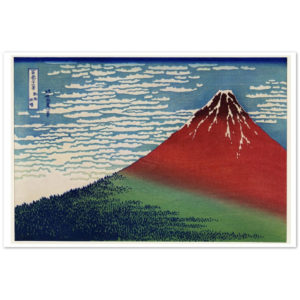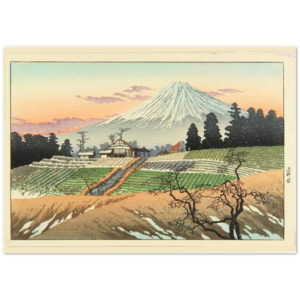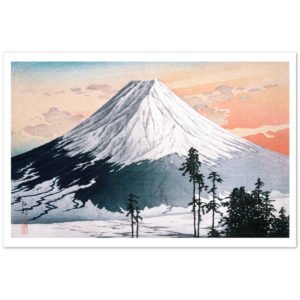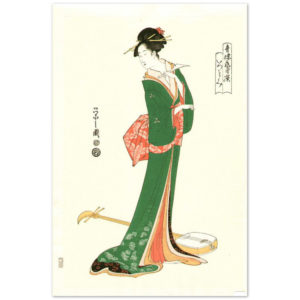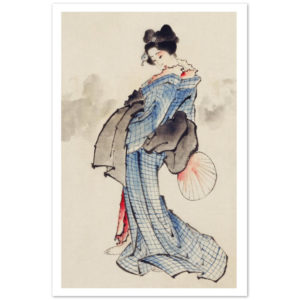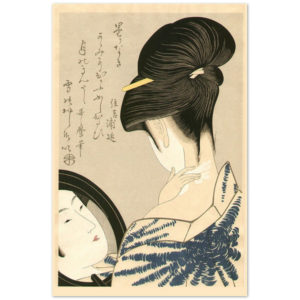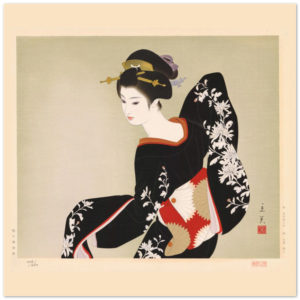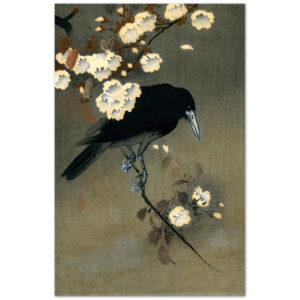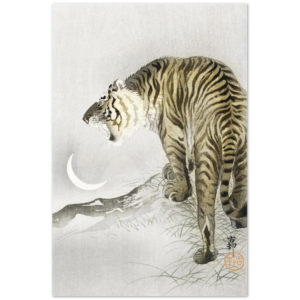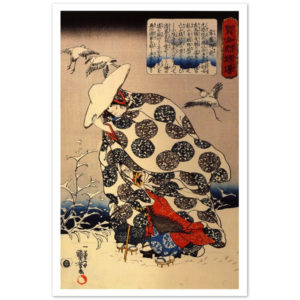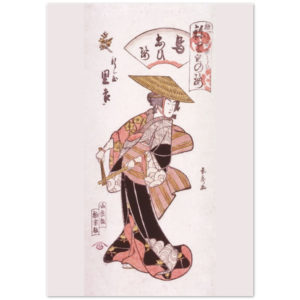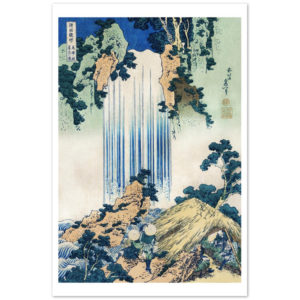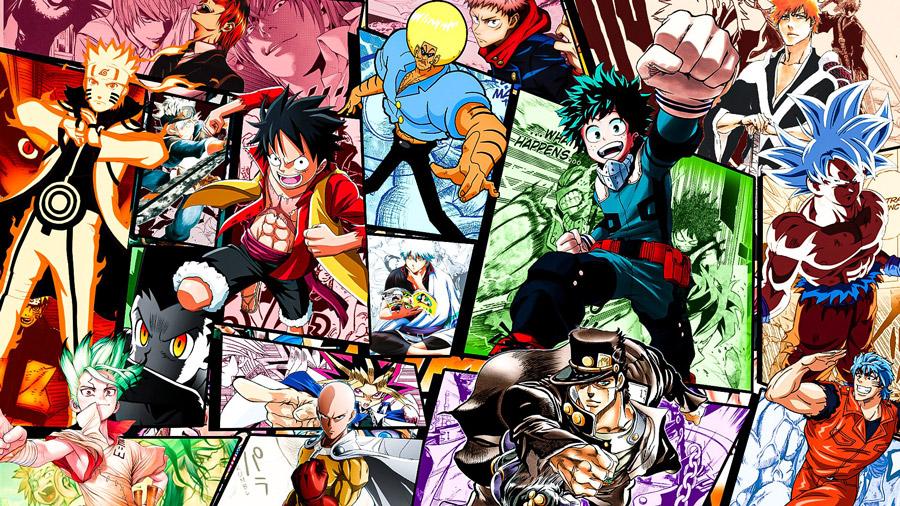Japanese prints, also known as ukiyo-e, have a long and storied history dating back to the Edo period (1603-1868). Ukiyo-e, which translates to “pictures of the floating world,” was a genre of art that emerged in Japan during this time and depicted the leisurely lifestyle of the urbanised merchant class. These prints, created using woodblock printing techniques, became popular among the growing middle class and were widely circulated throughout Japan.
Historically, they were meant to represent the city’s pleasure districts during the Edo period, when the sensuous aspects of life were fostered within a peaceful living under the control of the Shoguns. These picturesque accounts not only record the typical weather and recreational pursuits of the time but also showcase the uniquely Japanese appreciation for art, poetry, nature, spirituality, romance, and erotica.
Ukiyo-e prints were often brightly coloured and featured intricate details, making them a joy to behold. The popularity of ukiyo-e in the West during the late 19th and early 20th centuries played a role in developing the Impressionist and Post-Impressionist movements. Artists such as Vincent van Gogh and Claude Monet were inspired by the bold colours and compositional techniques of ukiyo-e and incorporated these elements into their work. These prints depicted the leisurely lifestyle of the merchant class, with a focus on pleasures such as kabuki theatre, geisha, and courtesans.
In Japan, screens and scrolls were often used to display these, which added to their storytelling quality. Although each artist contributed their unique flair, a popular pattern emerged that continued the Yamato-e heritage of Japanese painting by emphasising aerial viewpoints, exact details, clean contours, and flat colour.
Landscapes

Ukiyo-e is an overarching style under which several creative themes developed into what are today recognised as signature themes. Within this category were photographs of attractive ladies, eroticism, pictures of persons with large heads, floral arrangements, and even depictions of well-known natural landmarks like Mount Fuji.
Japanese landscape prints, known as fūkeiga, were often inspired by the country’s natural beauty, including mountains, forests, and coastlines.
Japanese print landscape art depicted people travelling through nature, fueling the desire for real-life adventure. While travel was strictly controlled during this time, some pilgrimages to sacred sites, temples, and shrines were allowed. And for those unable to visit in person, these prints served as the perfect way to fuel their wanderlust.
Today, as Japanese prints have become popular around the globe – especially among artists and collectors in Europe and the US – the dream of travelling to Japan became more and more attainable. So why wait? Start planning your trip today!
Portraits

Japanese portrait prints, bijin-ga, featured images of beautiful women, often depicted in traditional dress or engaged in everyday activities. Collectors highly sought these prints, and they were often given as gifts.
During the Meiji Era (1868-1912), portraits of beautiful ladies known as bijin-ga shifted from just showcasing physical attractiveness to honouring inner beauty. Many talented artists emerged during this time, including Kiyokata Kaburaki (1878-1972), who was renowned for his emotionally charged portraits; Shinsui Ito (1898-1972), who preferred to depict real women; and Uemura Shoen (1875-1949), a female artist who gave her subjects an air of dignity and refinement. These artists proved that true beauty radiates from within!”
There were usually horizontal prints of landscapes and portraits, but sometimes there would be vertical and narrow prints designed to give the impression of a scroll that could be hung from the sides of columns. The artist’s taste and the shifting ideals of Japanese society’s beauty were represented in these works. Performers were often shown as stock figures in early yakusha-e, but later on, masters like Katsukawa Shunsh started to paint more realistic pictures of their subjects.

The Japanese word “Kachō-ga” literally means “images of flowers and birds,” but the genre includes much more than just those two subjects. In fact, it encompasses the entire living natural world, focusing on plants, animals, and insects. What really caught the attention of European avant-garde artists, however, was how these flowers and birds were depicted.
Kachō-ga prints were not just admired for their beauty, however. These works of art also had cultural and symbolic significance in Japan. For example, certain flowers and birds were associated with specific seasons or events, and their inclusion in kachō-ga prints helped to convey these associations. This way, kachō-ga served to celebrate and honour Japan’s natural world and cultural traditions.
The traditional Chinese art form of painting flowers, birds, fish, and insects served as its inspiration. In kachô-ga, blank space was strategically used to emphasise the purity and serenity of natural life by pairing a single bird species with a single plant and leaving most of the nearby area as vast expanses of colour.
Creating depictions of birds and flowers was a staple of the ukiyo-e art form, giving artists a feeling of satisfaction with their accomplishments and a connection to a lengthy history. Numerous artists, such as Hokusai and Hiroshige, produced similar works, frequently incorporating the language of a classical poem or making an allusion to a historical or cultural context.
The Warriors of Japan

Musha-e, also known as “military pictures,” were Japanese prints that depicted warriors and scenes from Japanese history and folklore. These prints were popular during the Edo period (1603-1868) and often featured samurai, the elite warrior class of Japan, and other military figures such as generals and feudal lords.
In 1646, the very first musha-e was published; these prints, depicting fierce fights fought by honourable samurai, explored ideas of vengeance, honour, jealousy, and fury. Though musha-e and Kabuki theatre explored comparable ground, the former stayed authentic to the original wartime narratives while the latter adapted them for the play.
Heroes from the past had a limited audience in ukiyo-e compared to the glamorous concubines of Yoshiwara and the dramatic players of the Kabuki theatre. Although the actresses and courtesans of the time were the most famous people in the world, musha-e dealt only with the past and frequently the very ancient era.
One of the most famous musha-e artists was Utagawa Kuniyoshi, known for his dynamic and detailed prints depicting battles, duels, and other warrior-themed subjects. Kuniyoshi’s works were popular among the samurai class and helped to cultivate a sense of pride and honour among these elite warriors.
In addition to scenes of battle and conflict, musha-e also depicted everyday life in the warrior class, including training, armour and weapon maintenance, and other cultural traditions. These prints provided a glimpse into the samurai’s world and helped shape how they were perceived by the general public.
Final Words on Ukiyo-e
Today, Japanese prints continue to be collected and admired by art lovers worldwide. If you’re interested in ordering and collecting Japanese prints, it’s essential to do your research and familiarise yourself with the different genres and themes. Look for prints in good condition, with vibrant colours and crisp lines, and consider the artist and the historical context in which it was created. With careful selection, a collection of Japanese prints can be a beautiful and meaningful addition to any art lover’s collection.





































